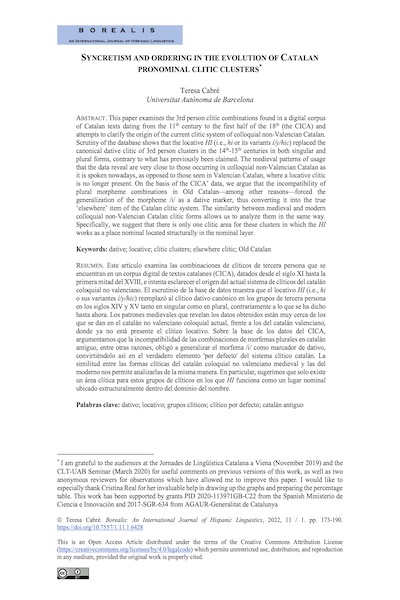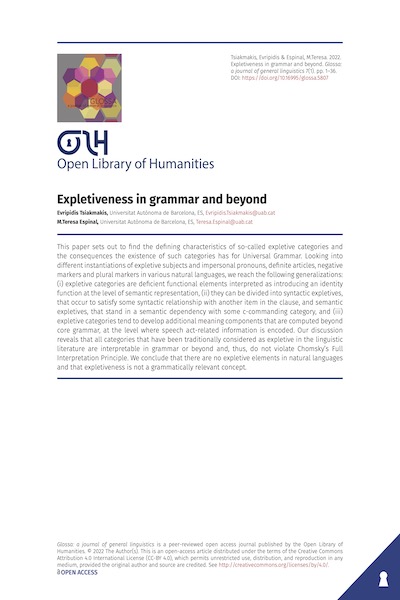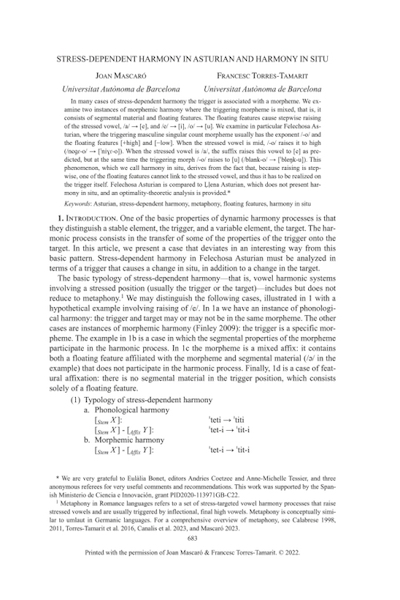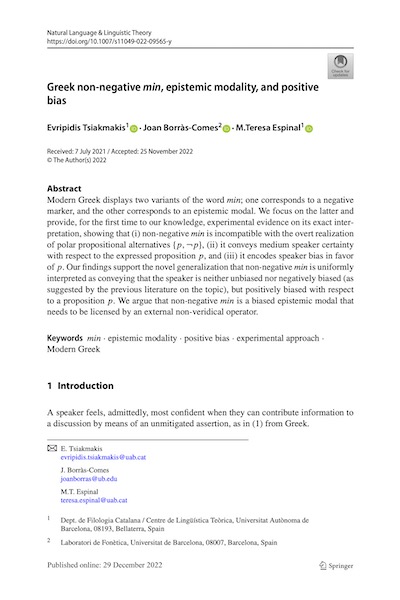18 gener, 2022

Autors:
Teresa Cabré
Títol:
Syncretism and ordering in the evolution of Catalan pronominal clitic clustersEditorial: Borealis: An International Journal of Hispanic Linguistics, 11(1), pp. 173-190
Data de publicació: Maig de 2022
Més informacióThis paper examines the 3rd person clitic combinations found in a digital corpus of Catalan texts dating from the 11th century to the first half of the 18th (the CICA) and attempts to clarify the origin of the current clitic system of colloquial non-Valencian Catalan. Scrutiny of the database shows that the locative HI (i.e., hi or its variants í/y/hic) replaced the canonical dative clitic of 3rd person clusters in the 14th-15th centuries in both singular and plural forms, contrary to what has previously been claimed. The medieval patterns of usage that the data reveal are very close to those occurring in colloquial non-Valencian Catalan as it is spoken nowadays, as opposed to those seen in Valencian Catalan, where a locative clitic is no longer present. On the basis of the CICA’ data, we argue that the incompatibility of plural morpheme combinations in Old Catalan—among other reasons—forced the generalization of the morpheme /i/ as a dative marker, thus converting it into the true ‘elsewhere’ item of the Catalan clitic system. The similarity between medieval and modern colloquial non-Valencian Catalan clitic forms allows us to analyze them in the same way. Specifically, we suggest that there is only one clitic area for these clusters in which the HI works as a place nominal located structurally in the nominal layer.
8 juny, 2022

Autors:
Tsiakmakis, E. & M.T. Espinal
Títol:
Expletiveness in grammar and beyondEditorial: Glossa: a journal of general linguistics, 7(1)
Data de publicació: Maig del 2022
Text completThis paper sets out to find the defining characteristics of so-called expletive categories and the consequences the existence of such categories has for Universal Grammar. Looking into different instantiations of expletive subjects and impersonal pronouns, definite articles, negative markers and plural markers in various natural languages, we reach the following generalizations: (i) expletive categories are deficient functional elements interpreted as introducing an identity function at the level of semantic representation, (ii) they can be divided into syntactic expletives, that occur to satisfy some syntactic relationship with another item in the clause, and semantic expletives, that stand in a semantic dependency with some c-commanding category, and (iii) expletive categories tend to develop additional meaning components that are computed beyond core grammar, at the level where speech act-related information is encoded. Our discussion reveals that all categories that have been traditionally considered as expletive in the linguistic literature are interpretable in grammar or beyond and, thus, do not violate Chomsky’s Full Interpretation Principle. We conclude that there are no expletive elements in natural languages and that expletiveness is not a grammatically relevant concept.
10 gener, 2023

Autors:
Joan Mascaró & Francesc Torres-Tamarit
Títol:
Stress-dependent harmony in Asturian and harmony in situEditorial: Language, Linguistic Society of America
Data de publicació: Desembre del 2022
Pàgines: 33 Més informacióIn many cases of stress-dependent harmony the trigger is associated with a morpheme. We examine two instances of morphemic harmony where the triggering morpheme is mixed, that is, it consists of segmental material and floating features. The floating features cause stepwise raising of the stressed vowel, /a/ → [e], and /e/ → [i], /o/ → [u]. We examine in particular Felechosa Asturian, where the triggering masculine singular count morpheme usually has the exponent /-o/ and the floating features [+high] and [−low]. When the stressed vowel is mid, /-o/ raises it to high (/neɡɾ-o/ → [ˈniɣɾ-o]). When the stressed vowel is /a/, the suffix raises this vowel to [e] as predicted, but at the same time the triggering morph /-o/ raises to [u] (/blank-o/ → [ˈbleŋk-u]). This phenomenon, which we call harmony in situ, derives from the fact that, because raising is stepwise, one of the floating features cannot link to the stressed vowel, and thus it has to be realized on the trigger itself. Felechosa Asturian is compared to Ḷḷena Asturian, which does not present harmony in situ, and an optimality-theoretic analysis is provided.
29 desembre, 2022

Autors:
Evripidis Tsiakmakis, Joan Borràs-Comes & M.Teresa Espinal
Títol:
Greek non-negative min, epistemic modality, and positive biasEditorial: Natural Language & Linguistic Theory (Springer)
Data de publicació: 29 de desembre del 2022
Text completModern Greek displays two variants of the word min; one corresponds to a negative marker, and the other corresponds to an epistemic modal. We focus on the latter and provide, for the first time to our knowledge, experimental evidence on its exact interpretation, showing that (i) non-negative min is incompatible with the overt realization of polar propositional alternatives {p,¬p}, (ii) it conveys medium speaker certainty with respect to the expressed proposition p, and (iii) it encodes speaker bias in favor of p. Our findings support the novel generalization that non-negative min is uniformly interpreted as conveying that the speaker is neither unbiased nor negatively biased (as suggested by the previous literature on the topic), but positively biased with respect to a proposition p. We argue that non-negative min is a biased epistemic modal that needs to be licensed by an external non-veridical operator.









